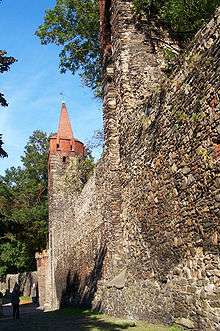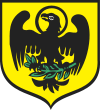Paczków
| Paczków | |||
|---|---|---|---|
|
Town hall | |||
| |||
 Paczków | |||
| Coordinates: 50°27′N 17°0′E / 50.450°N 17.000°E | |||
| Country |
| ||
| Voivodeship | Opole | ||
| County | Nysa | ||
| Gmina | Paczków | ||
| Government | |||
| • Mayor | Artur Rolka | ||
| Area | |||
| • Total | 6.6 km2 (2.5 sq mi) | ||
| Population (2006) | |||
| • Total | 8,147 | ||
| • Density | 1,200/km2 (3,200/sq mi) | ||
| Time zone | CET (UTC+1) | ||
| • Summer (DST) | CEST (UTC+2) | ||
| Postal code | 48-370 | ||
| Car plates | ONY | ||
| Website | http://www.paczkow.pl | ||
Paczków [ˈpat͡ʂkuf] (German: Patschkau) is a town in Nysa County, Opole Voivodeship, Poland, with 8,226 inhabitants (2004). It is one of the few towns in Europe in which medieval fortifications have been almost completely preserved.[1] Located in the southeastern outskirts of the historical province of Lower Silesia, along the medieval road from Lesser Poland to Klodzko Valley and Prague, Paczków is called "Polish Carcassonne", thanks to its well-preserved medieval fortifications.[2][3] However, while the famous French Carcassonne is a 19th-century reconstruction, all historic buildings of Paczków are authentic.[4]
The old town and its medieval fortifications are listed as one of Poland's official national Historic Monuments (Pomnik historii), as designated November 13, 2012. Its listing is maintained by the National Heritage Board of Poland.
History
Paczków (its name comes from the old Slavic first name Pakoslaw) was officially founded on March 8, 1254,[5] when the Bishop of Wrocław, Tomasz I gave permission for the location of a new town. It was placed near the ancient village of Paczków, and henceforth, the name of the village was changed to Old Paczków. Paczków quickly grew, becoming not only a market town, but also a stronghold, guarding southwestern borders of the mighty ecclesiastical Duchy of Nysa.[6] It was granted the so-called Flemish rights, based on Magdeburg rights. The new town received several privileges, such as the right to brew beer, and its early inhabitants were mostly craftsmen, such as bakers, butchers and shoemakers.
In the late Middle Ages and subsequent periods, Paczków shared the stormy fate of other towns of Silesia, with frequent disasters, such as hunger (1325), floods (1333, 1501, 1539, 1560, 1598, 1602), fires (1565, 1634), as well as epidemics - Black Death (1349), and cholera (1603–1607, 1633). Paczków also suffered during the Hussite Wars, when it was captured by the Hussites on March 17, 1428.[6] The period of religious wars did not end until the late 15th century, and only then did Paczków begin to flourish again. With the financial support of the bishops of Nysa, new fortifications were constructed, with a wall and towers. In 1526 Paczków, together with the whole of Silesia, passed to the Austrian Habsburg dynasty (see also Silesian Piasts). The 16th century was the best period in the history of the town. It was a major centre of trade, with several manufacturers of textiles. The end of prosperity came during the Thirty Years' War, when warring armies destroyed Paczków and adjacent areas.[6] In 1742, after the Silesian Wars, Paczkow was annexed by the Kingdom of Prussia (see also Austrian Silesia), and it subsequently became part of the German Empire. The town, known then as Patschkau, remained within the borders of Germany until 1945, when, following the Potsdam Agreement, it was placed under Polish administration, and renamed to its Polish name. Its German population was largely evacuated or expelled and replaced with Poles, most of whom came from current Western Ukraine (see: Kresy), mostly from areas of Lviv, Ternopil, and Volhynia.[7]
Monuments
Unlike nearby Nysa, World War II spared Paczków, and most of its monuments have been preserved. Called "The Polish Carcassonne" (or "The Silesian Carcassonne"), as early as in the 15th century, it was surrounded by double ring of defensive walls. Initially, the fortifications were made of dirt and wood, but later they were replaced by mightier stone walls.
The first fortifications of Paczków were built in the mid-14th century upon the order of the Bishop of Wrocław, Przeclaw z Pogorzeli.[1] In the mid 15th century, Paczków had three gates - Wrocław Gate (eastern), Klodzko Gate (western), and Zabkowice Slaskie Gate (southern). In the second half of the 16th century, the northern Nysa Gate was added. Vertical, 9-metre walls made from stone still surround the historical centre of the town today. Altogether, the fortifications are around 1200 metres long,[8] and apart from four gates, there originally were 24 wall towers, out of which 19 have been preserved. Along the defensive walls, there was a moat, which has been turned into a recreational park.
Besides its fortifications, Paczków is famous for renaissance, baroque, and neoclassic tenement houses, which surround the town square. The oldest of these buildings date back to around 1500,[1] with the most visible being the so-called "House of the Executioner". Also, in the centre of Paczków, there is the town hall, with 48-metre high tower.
Another interesting monument of "Polish Carcassonne" is the Church of John the Evangelist, which is considered to be one of the most impressive fortified churches in Poland.[1] Its construction began in 1350, and lasted for 30 years. The unique Gothic church, which is made of stone and bricks displays a renaissance attic, and its mighty structure has been incorporated into the town's fortifications.[2] The church stands out because of its immense size, and inside there are sculptures attributed to Wit Stwosz. Next to the complex there is the so-called Tatar well. According to a legend, a Tatar warrior (see Mongol invasion of Poland) was thrown into the well, after he had captured the daughter of a wealthy inhabitant of Paczków.
People
- Paweł Kukiz
- Joseph Schröter (1837–1894), German scientist
Gallery
 Panorama of the town.
Panorama of the town. City Walls in Paczkow.
City Walls in Paczkow.- Church of John the Evangelist
 Pre-Schengen passport stamp from border crossing into the Czech Republic at Bílý Potok.
Pre-Schengen passport stamp from border crossing into the Czech Republic at Bílý Potok.
External links
- Official webpage of the town
- Photo gallery of Paczkow
- Jewish Community in Paczków on Virtual Shtetl
| Wikimedia Commons has media related to Paczków. |
Coordinates: 50°27′35″N 17°00′10″E / 50.45972°N 17.00278°E
References
- 1 2 3 4 Gazeta Wyborcza. Piotr Walczak, Odwiedz polskie Carcassonne (Visit Polish Carcassone) retrieved on April 21, 2009
- 1 2 Panorama of Polish cities. Silesian Carcassone
- ↑ Poland’s Official Travel Website, Paczkow - Polish Carcassone
- ↑ Castles.info, Silesia and Opolskie
- ↑ Panorama of Polish cities. Silesian Carcassone"The intricate history of the town dates back to the 13th century; in 1254 Paczków was granted town status"
- 1 2 3 History of Paczkow at portal paczkow info
- ↑ Official webpage of town and commune of Paczkow
- ↑ Carta Blanca Publishing House, Paczkow


